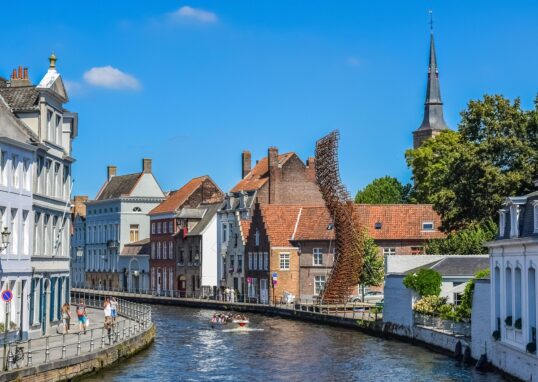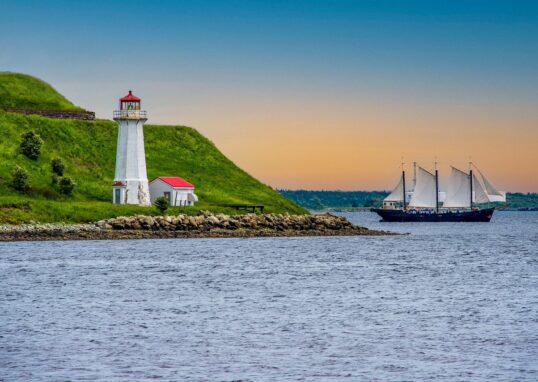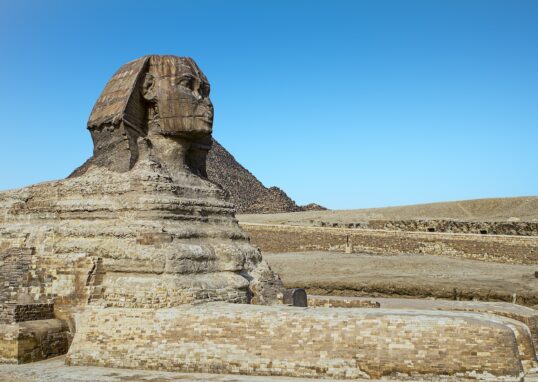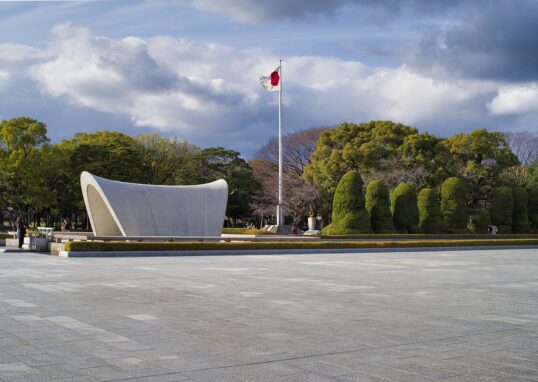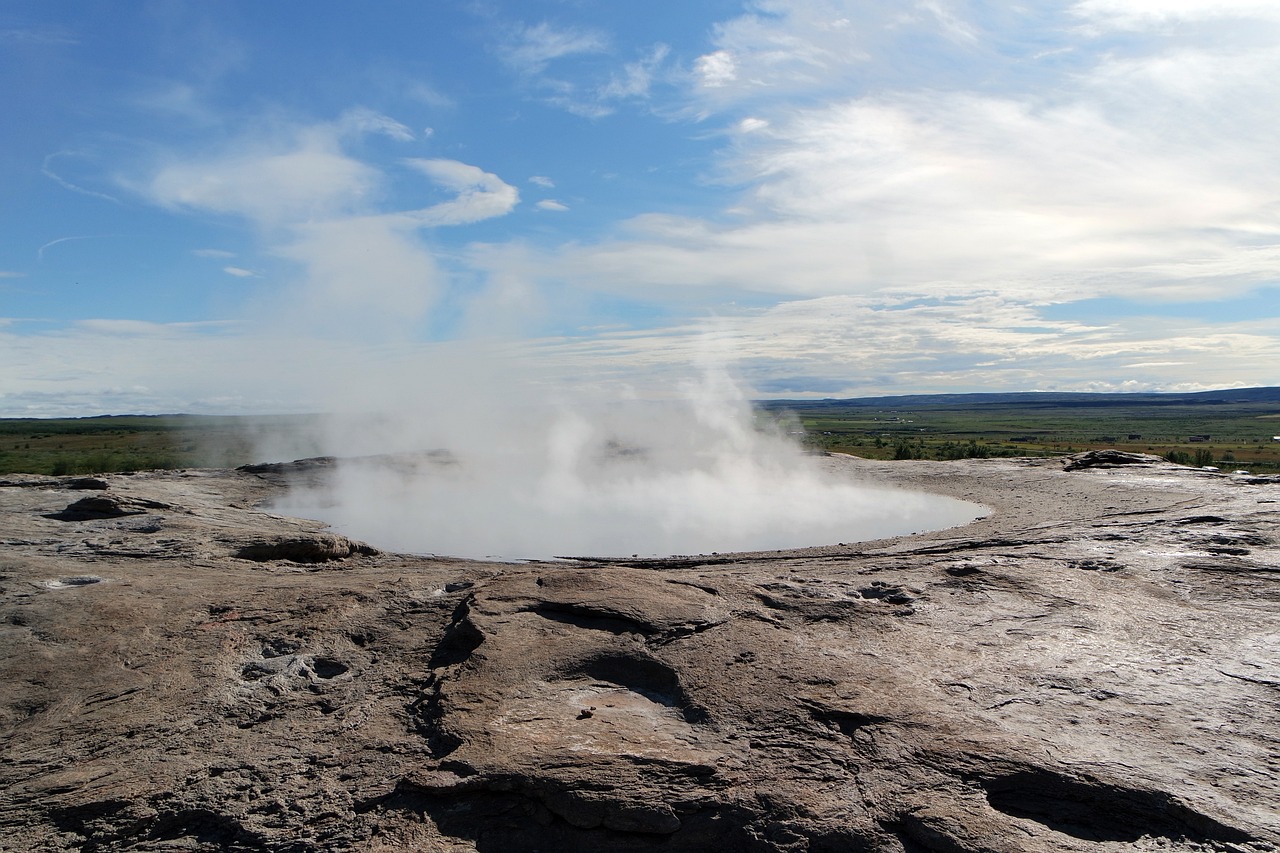
Portal to the Underworld: Geysir’s Boiling Whisper to the Sky
One of the most recognizable and, at the same time, most beloved natural tourist spots in Iceland’s Haukadalur Valley is none other than the Great Geysir, the world’s oldest known geyser. It is situated in the so-called “Golden Circle,” one of the most visited tourist routes alongside the National Park of Þingvellir and the Gullfoss waterfall. Being the first geyser described in European literature, it became a source for the word “geysers” to describe other geysers globally. The Great Geysir is now largely dormant, but the nearby Strokkur Geyser remains active, thrilling visitors with its regular eruptions. The Geysir and its reasons for remaining an essential attraction for nature lovers will be examined in detail.
The Great Geysir, Iceland
Location and Geological Setting
In the Haukadalur geothermal valley, a geothermal area, Geysir is one of the most active geothermal centers. This area is approximately 100 km (62 mi) from Reykjavik, a big city in Iceland. It is a terrain with many natural occurrences, such as the steaming of vents, the bubbling of mud, and the eruption of numerous active and inactive geysers, which turn it into a geothermal adventure site. This geothermal area is situated on top of a fault line, where the two major tectonic plates (Eurasian and North American) meet, generating tremendous geothermal heat.
The geothermal activity in this area is a result of subterranean magma chambers that warm the groundwater, causing it to rise to the surface as geysers and hot springs. The presence of sulfur and minerals contributes to the pools and springs’ vivid, almost unreal coloring, ranging from milky blue to sulfuric yellow.
History and Origins of the Great Geysir
The Great Geysir has a history dating back to the 13th century. According to local folklore, an earthquake in 1294 created a series of new hot springs, including the Geysir. According to historical records, the Great Geysir could achieve a height of 170 meters (558 feet); however, its power gradually decreased over time. Throughout the centuries, subsurface activity has caused the geyser’s various eruptions and periods of dormancy.
The word “geyser” is from the Icelandic word “geyser,” meaning to gush out, inspired by Geysir’s violent eruptions. Around the 18th century, Geysir became a highly popular tourist destination, attracting many European travelers to experience the overwhelming power of the geyser.
Dormancy and Reawakening
From the beginning of the 20th century, the Great Geysir has been essentially inactive, causing rare eruptions throughout the period. Sometimes, however, the geyser was “awakened” due to earthquakes, which led to eruptions. In contrast to the previous case, an earthquake in 2000 caused the geyser to reactivate for a short period, potentially leading to as many as eight eruptions per day. Meanwhile, it returned to dormancy within a short time.
In the past, people in the area even used soap to cause geysers to erupt, although that practice was soon stopped due to environmental dangers. Nowadays, those eruptions are still uncommon and unpredictable, as the world still looks towards the end of the natural Wonder.
Strokkur: The Reliable Geyser
Although dormant, Geysir has only been the main attraction of the valley; Strokkur, the neighboring one, has de facto become the point of interest in the Haukadalur Valley. Approximately every 5 to 10 minutes, Strokkur releases water jets radiating up to 15–20 meters (50–65 feet) into the air. The regular bursts of Strokkur erupt every 10 minutes, allowing guests and photographers to frame the geyser explosion with almost absolute certainty of capturing a geyser eruption. Strokkur shoots water molecules craftily and dynamically, and tourists circle around it to avoid missing the central climax point.
Visiting the Geysir Geothermal Area
The Geysir Geothermal Area paths are marked, and viewing decks have been installed, allowing visitors to observe the various hot springs, steam vents, and mud pots. The signs instruct tourists to stay only on the authorized paths, as the ground is too hot in these areas and, therefore, hazardous. The landscape is pierced by steam rising from several scattered vents; thus, the occurrence is ephemeral but breathtaking.
Visitor Center
The visitor center near Geysir offers a range of amenities, including educational exhibits, restaurants, and shops. It is the ideal place for tourists to learn about geothermal activity, Iceland’s unique geology, and the area’s history. Teachers usually explain the science behind the geysers and Iceland’s volcanic activity shortly afterward, where visitors can investigate the interactive exhibits, which are divided into.
Photography Tips
Strokkur’s predictability provides photographers with an opportunity to capture eruptions. A usual way is to take the shot with a fast shutter speed, which allows the camera to freeze the powerful movement of the water. The shift of colors of the geyser pools under light from different angles is mostly documented with suitable lighting in the morning and late afternoon when light plays best within nature.
Environmental Impact and Conservation Efforts
The heavily visited area needs conservation efforts to safeguard the sensitive environment around Geysir. Icelandic authorities have used boardwalks and paths to reduce human interaction with nature. Tourists are told not to throw objects around or disturb the geothermal features.
Local conservation organizations, in turn, educate tourists and raise awareness about the sensitivity of geothermal regions to pollution and physical damage, which can be devastating to ecosystems. Tourism funds also help support conservation projects, ensuring that future generations will continue to find Iceland’s natural beauty a source of joy.
Nearby Attractions in the Golden Circle
The geographical location of Geysir to the Golden Circle, a worldwide known route that also includes several other prominent attractions:
- Gullfoss Waterfall: From Gullfoss, it is only a brief car ride to Geysir. The waterfall itself is powerful and beautiful. Its identity, Golden Falls, derives from how sunlight plays over the water, making it appear golden. A walk along the trail provides breathtaking views from varying perspectives.
- Þingvellir National Park: Þingvellir is a UNESCO World Heritage Site and one of Iceland’s most important historical and geological sites. It is the site of Iceland’s ancient parliament, the Alþingi, and it is also the location where the Eurasian and North American tectonic plates are being thrust apart, forming a great rift valley.
- Kerid Crater: Another frequent stop is Kerid, a distinctive volcanic crater lake with brilliantly tinted water. The lake is surrounded by deep red and black volcanic rocks, which sharply contrast the blue-green water. Hence, it is a unique natural attraction along the trail.
The Cultural and Spiritual Significance of Geysers in Iceland
Geysers are a cherished tradition in Icelandic culture. In Icelandic folklore and literature, the power of geysers, volcanoes, and other natural events often represents the country’s wild and untamed energy. Some regional myths even claim the existence of trolls and spirits associated with geysers, clearly demonstrating Icelanders’ profound reverence for nature.
Travel Tips for Tourists
- Best Time to Visit: One can visit them all year round, although summer and winter differ significantly in what they have to offer. Summer (June to August) has a warmer climate, while winter is a chance to experience the unique beauty of a snowy country and see the crowds out.
- Clothing and Gear: Iceland’s weather is unpredictable, so wearing appropriate clothing is essential. This includes putting on several layers and rain and wind gear. Raincoats that don’t soak through are very important. Likewise, strong shoes and thermal clothing are essential safety items recommended for winter.
- Transportation: Countless tourists prefer self-driving trips to the Golden Circle, but guided bus tours are also in high demand. Both alternatives are recommended because visitors can be more flexible and have guides with excellent knowledge to make the excursion more productive.
The Geysir region is part of the Golden Circle of Iceland, a popular tourist route that includes Thingvellir National Park and Gullfoss Waterfall. Reykjavik, Iceland’s capital and an attraction on any journey to the country is easily accessible. The geothermal region is home to various types of hot springs, fumaroles, and mud pots, all of which indicate intense geothermal activity below the surface of Iceland. The steam-bubbling pool and the smell of sulfur are connected to the other environments in the area.
The Big Geyser, after which all the geysers are named, has a long and fascinating history. It was first mentioned in a written post in 1294 and has provoked for thousands of years. However, activity has decreased over time due to natural changes in the gender system and human intervention, for example, the use of soap to induce explosions in the past.
Conclusion
Despite its death, the great gossip symbolizes a place of geological heritage and Iceland’s great geological significance. Another travel spot, similar to Greenland, which holds one of the world’s highest ice sheets, is one of the most magnificent and natural sites on our planet. The Great Geysir and the nearby geothermal phenomena in the Haukadalur Valley of Iceland offer a rare experience of recent geothermal activity, as well as the natural beauty of the country. The Great Geysir, notwithstanding, is not so actively detonating anymore. Yet, Strokkur keeps the crowd screaming with delight through its regular and reliable bursts, which is a testament to its power. The zone is not only a dermatological wonder that comes alive with the elements of nature but also connects Iceland directly to the earth’s raw power.






